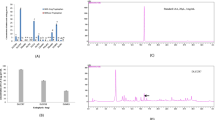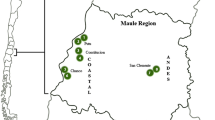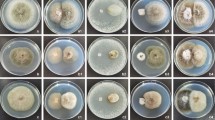Abstract
Orchid mycorrhizal fungi are essential for the seed germination and vegetative growth of orchids. The orchid Bletilla striata has great medical value in China because its tuber is rich in mannan. Some endophytic fungi were isolated from the roots of B. striata. The isolate KB-3 was selected for experiments because it could promote the germination of B. striata seeds. Based on morphological characters and phylogenetic analysis, the isolate KB-3 was identified as Fusarium oxysporum. Co-cultivation experiments of KB-3 with B. striata and Dendrobium candidum were performed to demonstrate orchid mycorrhizal structures. Microscopic examination showed that KB-3 established colonization and produced coiled hyphal structures known as pelotons within the cortical cells of both orchid roots. The results confirm that F. oxysporum KB-3 can behave as an orchid mycorrhizal fungus.






Similar content being viewed by others
References
Andersen TF, Rasmusen HN (1996) The mycorrhizal species of Rhizoctonia. Rhizoctonia, species: taxonomy, molecular biology, ecology, Pathology and disease control. Springer, Dordrecht, pp 379–390
Artursson V, Finlay RD, Jansson JK (2006) Interactions between arbuscular mycorrhizal fungi and bacteria and their potential for stimulating plant growth. Environ Microbiol 8:1–10
Bayman P, Mosqueraespinosa AT, Saladiniaponte CM, Hurtadoguevara NC, Vieraruiz NL (2016) Age-dependent mycorrhizal specificity in an invasive orchid, Oeceoclades maculata. Am J Bot 103:1880–1889
Benyon F, Summerell BA, Burgess LW (1996) Association of Fusarium species with root rot of Cymbidium orchids. Australas Plant Pathol 25:226
Bidartondo MI, Burghardt B, Gebauer G, Bruns TD, Read DJ (2004) Changing partners in the dark: isotopic and molecular evidence of ectomycorrhizal liaisons between forest orchids and trees. Proc R Soc B Biol Sci 271:1799–1806
Bulpitt CJ, Li Y, Bulpitt PF, Wang J (2007) The use of orchids in Chinese medicine. J R Soc Med 100:558–563
Carbone I, Kohn LM (1999) A method for designing primer sets for speciation studies in filamentous ascomycetes. Mycologia 91:553–556
Chutima R, Dell B, Vessabutr S, Bussaban B, Lumyong S (2011) Endophytic fungi from Pecteilis susannae (L.) Rafin (Orchidaceae), a threatened terrestrial orchid in Thailand. Mycorrhiza 21:221–229
Dearnaley JDW (2007) Further advances in orchid mycorrhizal research. Mycorrhiza 17:475–486
Dearnaley JDW, Martos F, Selosse M-A (2013) Orchid mycorrhizas: molecular ecology, physiology, evolution and conservation aspects. In: Hock B (ed) The Mycota IX: fungal associations. Springer, Berlin, pp 207–230
Dearnaley JWD, Perotto S, Selosse M-A (2016) Structure and development of orchid mycorrhizas. In: Martin F (ed) Molecular mycorrhizal symbiosis. Wiley-Blackwell, Hoboken, pp 63–86
Ding R, Chen XH, Zhang LJ, Yu XD, Qu B, Duan R, Xu YF (2014) Identity and specificity of Rhizoctonia-like fungi from different populations of Liparis japonica (Orchidaceae) in Northeast China. PLoS One 9:e105573
Freitag M, Ciuffetti LM, Selker EU (2001) Expression and visualization of green fluorescent protein (GFP) as a reporter gene for the plant pathogenic oomycete Phytophthora palmivora. FEMS Microbiol Lett 178:71–80
Genre A, Chabaud M, Faccio A, Barker DG, Bonfante P (2008) Prepenetration apparatus assembly precedes and predicts the colonization patterns of arbuscular mycorrhizal fungi within the root cortex of both Medicago truncatula and Daucus carota. Plant Cell 20:1407–1420
Hadley G (1970) Non-specificity of symbotic infection in orchid mycorrhiza. New Phytol 69:1015–1023
Johnson TR, Stewart SL, Dutra D, Kane ME, Richardson L (2007) Asymbiotic and symbiotic seed germination of Eulophia alta (Orchidaceae) – preliminary evidence for the symbiotic culture advantage. Plant Cell Tissue Org Cult 90:313–323
Jones DL (2006) A complete guide to native orchids of Australia including the island territories. Reed New Holland, Sydney, pp 418–419
Katoh K, Toh H (2010) Parallelization of the MAFFT multiple sequence alignment program. Bioinformatics 26(15):1899–1900
Laurence MH, Summerell BA, Burgess LW, Liew EC (2014) Genealogical concordance phylogenetic species recognition in the Fusarium oxysporum species complex. Fungal Biol 118:374–384
Liu H, Luo Y, Liu H (2010) Studies of mycorrhizal fungi of Chinese orchids and their role in orchid conservation in China-a review. Bot Rev 76:241–262
Lorang JM, Tuori RP, Martinez JP, Sawyer TL, Redman RS, Rollins JA, Wolpert TJ, Johnson KB, Rodriguez RJ, Dickman MB, Ciuffetti LM (2001) Green fluorescent protein is lighting up fungal biology. Appl Environ Microb 67:1987–1994
McCormick MK, Whigham DF, O’Neill J (2004) Mycorrhizal diversity in photosynthetic terrestrial orchids. New Phytol 163:425–438
Nylander JAA (2004) MrModeltest, version 2.1. Evolutionary Biology Centre, Uppsala University, Uppsala. Program distributed by the author. http://www.abc.se/~nylander/
Ovando I, Damon A, Bello R, Ambrosio D, Albores V, Adriano L, Salvador M (2005) Isolation of endophytic fungi and their potential for the tropical epiphytic orchids Cattleya skinneri, C. aurantiaca and Brassavola nodosa. Asian J Plant Sci 4:309–315
Pimprikar P, Carbonnel S, Paries M, Katzer K, Klingl V, Bohmer MJ, Karl L, Floss DS, Harrison MJ, Parniske M, Gutjahr C (2016) A CCaMK-CYCLOPS-DELLA complex activates transcription of RAM1 to regulate arbuscule branching. Curr Biol 26:987–998
Rafter M, Yokoya K, Schofield EJ, Zettler LW, Sarasan V (2016) Non-specific symbiotic germination of Cynorkis purpurea (Thouars) Kraezl, a habitat-specific terrestrial orchid from the central highlands of Madagascar. Mycorrhiza 26:541–552
Rasmussen HN (1995) Terrestrial orchids - from seed to mycotrophic plant. Cambridge University Press, Cambridge 444 pp
Rasmussen HN (2002) Recent developments in the study of orchid mycorrhiza. Plant Soil 244:149–163
Sathiyadash K, Muthukumar T, Uma E, Pandey RR (2012) Mycorrhizal association and morphology in orchids. J Plant Interact 7:238–247
Shefferson RP, Wei M, Kull T, Taylor DL (2005) High specificity generally characterizes mycorrhizal association in rare lady’s slipper orchids, genus Cypripedium. Mol Ecol 14:613–626
Smith SE, Read DJ (2008) Mycorrhizal symbiosis. Academic, London
Stenglein SA, Balatti PA (2006) Genetic diversity of Phaeoisariopsis griseola in Argentina as revealed by virulence and molecular markers. Physiol Mol Plant Pathol 68:158–167
Swofford DL (2003) PAUP. Phylogenetic analysis using parsimony (and other methods). Version 4. Sinauer Associates, Sunderland
Tao G, Liu ZY, Liu F, Gao YH, Cai L (2013) Endophytic colletotrichum species from Bletilla ochracea (Orchidaceae), with descriptions of seven new speices. Fungal Divers 61:139–164
Tesitelova T, Tesitel J, Jersakova J, Rihova G, Selosse MA (2012) Symbiotic germination capability of four Epipactis species (Orchidaceae) is broader than expected from adult ecology. Am J Bot 99:1020–1032
Varma A, Bakshi M, Lou B, Hartmann A, Oelmueller R (2012) Piriformospora indica: a novel plant growth-promoting mycorrhizal fungus. Agric Res 1:117–131
Vollmer SJ, Yanofsky C (1986) Efficient cloning of genes of Neurospora crassa. Proc Natl Acad Sci U S A 83:4869–4873
Vujanovic V, Starnaud M, Barabe D, Thibeault G (2000) Viability testing of orchid seed and the promotion of colouration and germination. Ann Bot 86:79–86
Warcup JH, Talbot PHB (1967) Perfect states of Rhizoctonias associated with orchids. New Phytol 66:631–641
Waud M, Brys R, Van Landuyt W, Lievens B, Jacquemyn H (2017) Mycorrhizal specificity does not limit the distribution of an endangered orchid species. Mol Ecol 26:1687–1701
Weiß M, Waller F, Zucaro A, Selosse M-A (2016) Sebacinales — one thousand and one interactions with land plants (Tansley review). New Phytol 211:20–40
White TJ, Bruns T, Lee S, Taylor J (1990) Amplification and direct sequencing of fungal ribosomal RNA genes for phylogenetics. In: Innis MA, Gelfand DH, Sninsky JJ (eds) PCR protocols: a guide to methods and applications. Academic, Cambridge, pp 315–322
Williamson B, Hadley G (1970) Penetration and infection of orchid protocorms by thanatephorus cucumeris and other rhizoctonia isolates. Phytopathology 60:1092
Yao MK, Tweddell RJ, Désilets H (2002) Effect of two vesicular-arbuscular mycorrhizal fungi on the growth of micropropagated potato plantlets and on the extent of disease caused by Rhizoctonia solani. Mycorrhiza 12:235–242
Yeung EC (2017) A perspective on orchid seed and protocorm development. Bot Stud 58:33
Zhao X, Zhang J, Chen C, Yang J, Zhu H, Liu M, Lv F (2014) Deep sequencing-based comparative transcriptional profiles of cymbidium hybridum, roots in response to mycorrhizal and non-mycorrhizal beneficial fungi. BMC Genomics 15:747–747
Funding
This study is funded by the National Key Research and Development Program (2017YFD0201106), the Natural Science Fund of Education Department of Hubei province (D20181304), and the vegetable fertilizer and pesticide reducing team project of Hubei province.
Author information
Authors and Affiliations
Contributions
JJ executed all experiments except phylogenetic analysis and wrote the draft, KZ did the phylogenetic analysis and manuscript writing, ZS and YZ designed the experiments.
Corresponding authors
Additional information
Publisher’s note
Springer Nature remains neutral with regard to jurisdictional claims in published maps and institutional affiliations.
Electronic supplementary material
ESM 1
(DOCX 636 kb)
Rights and permissions
About this article
Cite this article
Jiang, J., Zhang, K., Cheng, S. et al. Fusarium oxysporum KB-3 from Bletilla striata: an orchid mycorrhizal fungus. Mycorrhiza 29, 531–540 (2019). https://doi.org/10.1007/s00572-019-00904-3
Received:
Accepted:
Published:
Issue Date:
DOI: https://doi.org/10.1007/s00572-019-00904-3




